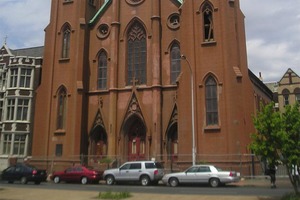For as long as Andrew R. Palewski can remember, he’s had an affinity for old buildings. But his fight to save the old Church of the Assumption from the wrecker’s ball may require a miracle.
Palewski, 36, an architectural preservationist, is working hard to prevent a local AIDS agency, Siloam Wellness, from demolishing the Catholic church at 1133 Spring Garden St.
The church was built in 1848 by noted architect Patrick Charles Keely and consecrated by St. John Neumann. Ten years later, St. Katharine Drexel was baptized there.
But 14 years ago, citing fewer than 20 parishioners, the Archdiocese of Philadelphia de-accessioned the building, which has since fallen into disrepair.
Siloam bought the church from the Archdiocese in March 2006, as part of a package deal that also included a rectory, convent, storefront and parking lot.
Siloam officials say the church is a drain on its resources and they don’t have the $5 million needed for its renovation. “Market forces are not going to save this building,” said Kevin R. Boyle, an attorney for Siloam.
The organization provides alternate treatments for HIV/AIDS, including yoga, massage therapy, nutritional counseling and stress-reduction therapies.

Siloam operates out of the rectory, which it wants to upgrade. It also wants to upgrade the convent, and hopes that other AIDS agencies will choose to occupy the space to streamline costs.
But those plans have been up in the air since last Friday’s 9-3 vote by the city’s Historical Commission to place the church on Philadelphia’s Register of Historic Places.
Palewski, who is leading the preservation effort, is very grateful for the vote, which effectively blocks the demolition. He presented the commission with a petition signed by 416 people who want the church spared from the wrecking ball.
He hopes Siloam will lease or sell the building to an individual or group that wants to convert the church for a new, productive use.
Boyle said he’s very frustrated with the vote.
“It’s easy for other people to tell you what to do with your property when they’re not responsible for it,” the attorney said. “It’s an over-simplistic solution to say, ‘Just sell it or lease it.’ Who has $5 million to renovate the property? And I think that figure is on the light side.”
Angela Ayukachale, outreach coordinator for Siloam, echoed Boyle’s frustration. “This organization could implode based on the hardship that’s happening,” she told the commission. “If our organization implodes, you’ve got more empty buildings.”
Palewski isn’t buying that.
“I personally do not see how preventing Siloam from demolishing this building will, in the least bit, put a damper on their operations,” he said, then pledged to work hard to ensure that the building’s continuation is good for both Siloam and the community.
William Schicktanz told the commissioners that his wife, local artist Qiongzhao Schicktanz, is interested in purchasing the church and turning it into an art gallery.
“She’s committed toward that end,” he said. “Obviously economics will play a role.”
Richard D. Keaveney, CEO of Metropolitan Area Neighborhood Nutrition Alliance, isn’t impressed with that possibility. In his opinion, the church’s demolition is the best option for Siloam.
“I’m supportive of the church coming down because the work that Siloam does in the 21st century is more important than a 19th-century building with marginal historical significance, at best,” Keaveney said. “The importance of Siloam’s programs far outweighs the façade standing on that ground, which, in my opinion, is an accident waiting to happen.”
Bevan Lawson, a structure engineer hired by Siloam, buttressed Keaveney’s position when he critiqued the condition of the building. He told the commission the church’s wood is rotting, nails are falling out, walls are bowing, bricks are turning into powder and there may be mold inside.
Palewski sat through Lawson’s presentation unfazed.
“There are buildings in much worse shape than this one that I’ve played a part in preserving and saving,” Palewski said. “This is a very doable project.”
Palweski said the $5-million figure represents the “upper end of the spectrum with regard to reuse.” He said someone renovating the building could spend much less than $5 million and “still end up with a completely watertight and usable building.”
Keaveney questioned what St. Katharine Drexel would do, if faced with the dilemma.
“She renounced her wealth, which included significant real-estate holdings, to fund services for Native American children,” he noted. “She wasn’t hung up on buildings. She was a pragmatist, not a sentimentalist.”
Palewski wasn’t so sure the saint would support the demolition.
“When you come through Philadelphia, you see this church, and there couldn’t be a better monument to Katharine Drexel’s beginnings,” he said. “Old buildings give us a link to the past and remind us of people no longer on this earth who continue to offer spiritual inspiration.”
Palewski said he also holds great regard for the work done by Siloam. “I am sympathetic towards those that have HIV/AIDS. I think it’s wonderful that Siloam is providing a place for them to go for moral support.”
Tim Cwiek can be reached at (215) 625-8501 ext. 208.
